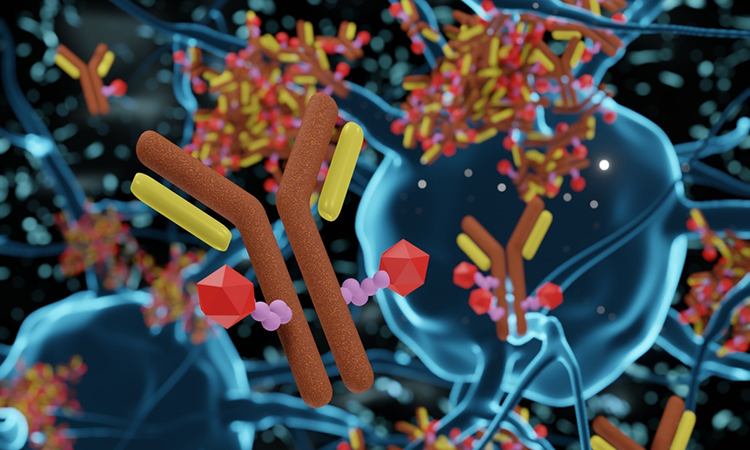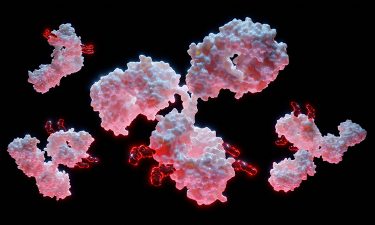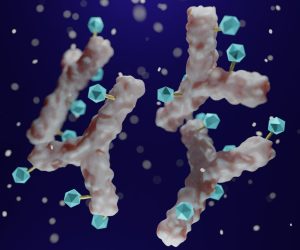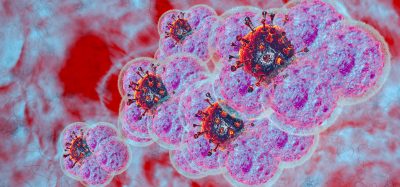Antibody Drug Conjugates: windows of opportunity
Posted: 4 July 2023 | Dr Jeff Mocny (Abenza), Dr Petra Dieterich (Abenza), Ian Glassford (Abenza) | No comments yet
This articles aims to drive understanding in Antibody Drug Conjugate (ADC) drug development to improve patient outcomes. Petra Dieterich, Ian Glassford, and Jeff Mocny, Scientific Leaders at Abzena discuss real-world data that is challenging traditional scientific thinking on the ADC therapeutic window. The authors also explore the need for further data to improve understanding and refine drug design with safety and efficacy in mind.

Over the last two decades, an increasing number of Antibody Drug Conjugate (ADC) therapeutics have been approved for oncology indications. These therapies have broadened treatment options for patients to expand beyond the more traditional small molecule drug alternatives. Through their unique modes of action, ADCs have been heralded as having the potential to positively impact not only cancer patient outcomes but also quality of life, an increasingly important factor in treatment decisions for this patient population.
ADCs have the potential to redress the poor balance between safety and efficacy seen with traditional cancer treatment options. With their targeted approach and ability to deliver cytotoxic payloads and maintain these at the site of need, they open up the opportunity to rethink many aspects of standard cancer treatment pathways. However, ADCs are a nascent therapeutic option and real-world clinical data is emerging daily that is shedding light on the utility and potential of this exciting modality to deliver against its promise.
In this article, Petra Dieterich, Ian Glassford, and Jeff Mocny, Scientific Leaders at Abzena discuss real-world data that is challenging traditional scientific thinking on the ADC therapeutic window. The authors also explore the need for further data to improve understanding and refine drug design with safety and efficacy in mind.
The drivers behind the demand for ADCs
Providing more targeted therapeutic options in the oncology space has underpinned the rapid growth of the ADC market; between 2016 to 2020, the US ADC market grew by 45 percent to a value of nearly $1.5 Billion. The global ADC market is expected to continue this steep upward trajectory and is anticipated to exceed $16 Billion by 2026.1
Regulators invest significant consideration balancing quality-of-life measures with overall survival when assessing novel oncology treatments. Patients and caregivers also assess the benefits offered by different therapies, weighing the progression-free survival with their off-target effects. In practice, some patients may be left managing a syndrome associated with the therapy along with the disease. This has spurred tremendous innovation in novel treatment strategies and is helping to fuel ADC market growth.
Improving efficacy with ADCs
The widely quoted notion that ADCs increase the therapeutic window by lowering the minimum effective dose (MED) and increasing the maximum tolerated dose (MTD) is not supported by clinical data from human studies, indicating the MTD of ADCs is not significantly different from small molecules.2 However, when dosed at the MTD, ADCs display improved efficacy over small molecules in oncology trials.

3D rendering of Antibody Drug Conjugate Molecules.
Whilst no trials have been performed directly comparing small molecules with their ADC counterparts, it is possible to contrast data from trials with ADCs to those performed with analogous small molecules. For instance, we can compare the data from the 2021 DESTINY-Gastric01 cancer trial using the ADC Trastuzumab Deruxtecan with data from a gastric cancer trial in 2004 using the small molecule Irinotecan. In both cases, the active ingredients are camptothecin-derived topoisomerase 1 inhibitors with similar proposed modes of action. In the ADC trial, the objective response rate (ORR) – defined as the percentage of patients whose disease decreased or disappears – was 42 percent whilst the ORR in the small molecule trial was 12.5 percent.2
Caution is always advised when comparing data from different trials, nevertheless, ADC treatments frequently score ORRs at >40 percent in breast, gastric, urothelial, and lung cancer trials where small molecules rarely exceed 25 percent. These results indicate that ADCs can achieve greater beneficial outcomes for patients.2
Further improving ADC therapeutic index
Driven by the fact that highly potent cytotoxic drugs have a strong linear relationship between dose and efficacy, the MTD set in a Phase 1 cancer study usually translates into the optimum dose used in later trials and in the marketed drug.
However, a more detailed look into the clinical data suggests that there is room for further dose optimisation, and this is exemplified by the small molecule drug Sotorasib. The first-in-class treatment for KRAS G12C-mediated non-small cell lung cancer was approved by the US FDA in 2021 and by the EMA in 2022 with orphan status and accelerated reviews. Although the ORR of Sotorasib (36 percent) met the statutory standard for accelerated approval, significant difficulties were observed.
In clinical trials, the highest dose was set at 960 mg; whilst judged to be well-tolerated, 45 percent of patients receiving this dose showed serious complications and 7 percent had to stop treatment. Based on these data, the FDA is requiring a post-approval dose optimisation study comparing the approved 960 mg dose of Sotorasib with the lower doses used in the Phase 1 trial. This post-marketing requirement is a clear example of the regulatory drive to better balance efficacy and safety. This is the first time this request has been made for a targeted oncology drug.

Antibody drug conjugated with cytotoxic payload. antibody linked to a biologically active cytotoxic (anticancer) payload or drug 3d rendering.
Patient advocacy groups, such as Friends of Cancer Research, are also encouraging regulators to ensure drug developers in the oncology space invest in the optimisation of dosing regimens to help better balance efficacy and safety and thereby deliver more effective patient outcomes. With the ultimate long-term goal of optimum dosing being determined before Phase 3 registration trials and before a drug is marketed.3
Dosing regimens are already being used to increase the therapeutic index of currently approved ADC treatments.4 They include body weight capping, treatment duration, dosing duration and frequency, response-guided dosing, and, as with Sotorasib, randomised dose-finding studies performed in the development phase being used to improve overall efficacy.
Dosing beyond theoretical MTDs
Comparing the MTDs of approved ADCs with those of small molecule drugs that are structurally equivalent to the cytotoxic payload provides clinical data indicating ADCs do not increase the MTD. Camptothecin-derived topoisomerase 1 inhibitors such as Irinotecan and Topotecan achieve human MTDs at >0.5 mg/kg, whereas their ADC counterparts, including Enhertu and Trodelvy, have much lower MTDs at <0.25 mg/kg.
The reasons why ADCs do not increase the MTDs are not fully understood, and more data and better understanding are needed to provide a full explanation. However, the effects of payload-linker stability and deconjugation in plasma are thought to play a significant role.
The majority of ADCs currently approved for use, or in clinical trials, are produced through coupling a maleimide moiety on the linker payload to the antibody. Bioconjugation via maleimide coupling generates ADCs which can be unstable, undergoing deconjugation via a retro-Michael reaction. This results in highly variable drug-to-antibody ratios.
Such deconjugation prior to engagement with target cancer cells can have a positive impact on tumor cell reduction, freeing up the cytotoxic moiety to interact with the cancer cells. However, it can also result in a reduced concentration of the cytotoxic agent reaching the cancer cells and a corresponding unwanted destruction of healthy cells. For example, deconjugation in plasma can lead to albumin binding which can cause non-specific payload disposition as well as direct tumor albumin uptake.
Whilst most commercially approved ADCs have relied on stochastic lysine and cysteine conjugation technologies, there is a clear trend toward the use of more site-selective options in pre-clinical and clinical-stage ADCs. These technologies include ThioBridge™ cysteine re-bridging technology, peptide-directed lysine conjugations such as AJICAP™, and enzyme-directed approaches including microbial transglutaminase and GlycoConnect™ enzyme-mediated glycan remodeling technology.
These conjugation options promise to produce more homogenous and easier-to-characterise conjugates that have the potential to translate into safer and more effective ADCs. The continued generation of data surrounding these newer technologies will contribute to our understanding of the mechanisms of action and ultimately allow scientists to design bioconjugates that provide the optimum outcomes for patients.
Looking to the future
ADCs are considered as the way to meet the need for a therapeutic option offering targeted effector functions whilst lowering dosing and minimising side effects and adverse events. As we begin to better understand payload release mechanisms and targeting strategies, the outlook for ADCs continues to be very promising. Whilst early clinical data is very promising, the full potential has yet to be realised, exemplified by off-target effects being seen in even the most successful ADC platforms, across indications. However, clear routes for improvement have been identified and are being actioned.
The biopharma industry is challenged to translate the latest innovations into next-generation medicines.
Driving towards lower dosing and better targeting to address safety concerns and enhance efficacy is a common goal that unites the global oncology research and development community. The biopharma industry is challenged to translate the latest innovations into next-generation medicines and to date focus on new targets and conjugation approaches to address issues including resistance.
ADC therapies may offer an opportunity to increase dosing well beyond the theoretical MTD where a vigorous, acute therapy course is employed. Using site-specific conjugation techniques, this approach may disrupt resistance mechanisms, ultimately resulting in a higher overall survival. To be successful we must consider the utility of unique linker strategies and take advantage of peculiarities associated with disease cells.
To deliver the dream of optimised ADC therapy continuous improvement is pivotal to ensure the full potential of these crucial therapeutics is realised, ultimately delivering a return on the investment in human health.
Author bios:
 Dr Petra Dieterich
Dr Petra Dieterich
Petra has 30 years’ experience of drug development in the Pharmaceutical industry with a focus on supporting CMC activities. She has held leadership positions in Project Management, Technical Operations and Business Development. Working in the CRO and CDMO environment she has led projects for customers across the globe, helping them to achieve their goals in clinical trials and low volume commercial manufacture. Petra holds a D.Phil in synthetic organic chemistry and am MBA from Imperial College London.
 Ian Glassford
Ian Glassford
Ian is an expert in ADCs and bioconjugation development and manufacture with 15 years’ experience in: design and synthesis of small molecules, development and scale-up of highly potent payloads, linker-payloads, and ADCs CMC Project Management.
 Dr Jeff Mocny
Dr Jeff Mocny
Jeff has 20 years of experience in regulated pharmaceutical and medical device product development in exploratory and late phase research, Intellectual Property, analytical method development and regulatory strategic consulting. He got his PhD in Microbiology and Immunology from the University of Buffalo, The State University of New York. At Abenza, Jeff is a strategist providing market, product and regulatory guidance to early and late phase development projects by leveraging quality management and risk mitigation approaches.
References:
- Do Pazo C, Nawaz K, Webster RM. The oncology market for antibody–drug conjugates. Nature Reviews Drug Discovery [Internet]. 2021 Mar 24 [cited 2021 Dec 16];20(8):583–4.
- Colombo R, Rich JR. The therapeutic window of antibody drug conjugates: A dogma in need of revision. Cancer Cell [Internet]. 2022 Nov 14 [cited 2023 Apr 6];40(11):1255–63.
- Moon H. FDA initiatives to support dose optimization in oncology drug development: the less may be the better. Translational and Clinical Pharmacology [Internet]. 2022 [cited 2023 Feb 10];30(2):71.
- Liao MZ, Lu D, Kågedal M, Miles D, Samineni D, Liu SN, et al. Model‐Informed Therapeutic Dose Optimization Strategies for Antibody–Drug Conjugates in Oncology: What Can We Learn From US Food and Drug Administration–Approved Antibody–Drug Conjugates? Clinical Pharmacology & Therapeutics. 2021 Jul 8;110(5):1216–30.
Related topics
Antibodies, Antibody Discovery, Oncology, Therapeutics
Related conditions
Cancer, Dr Jeff Mocny
Related organisations
Abenza







